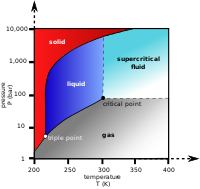
Photo from wikipedia
Cotton fiber is the most widely produced and utilized natural fiber with a popular usage in our planet. A substantial amount of clean water is utilized during conventional cotton fiber… Click to show full abstract
Cotton fiber is the most widely produced and utilized natural fiber with a popular usage in our planet. A substantial amount of clean water is utilized during conventional cotton fiber pretreatment. In this study, we investigated the bleaching possibility of knitted cotton fabric by using supercritical carbon dioxide as a medium, as a cleaner waterless alternative, at pressures in the range of 180 and 250 bar and at temperatures ranging from 80 °C (at the pressure of 180 bar with 505 kg/m3) to 120 °C (at the pressure of 250 bar with 539 kg/m3) for 20 min with either solely hydrogen peroxide usage at 5% and 15% concentrations or combination usage of hydrogen peroxide with necessary related auxiliaries such as peroxide stabilizer at 1% and 8% concentrations and caustic soda at 3% concentration in comparison with conventional aqueous hydrogen peroxide bleaching process in order to support environmentally friendly, sustainable textile production leading to more sustainable future for our planet. Also, the effects of different washing types as after-treatment process following waterless and aqueous peroxide bleaching processes on the whiteness performance of cotton fabrics were also explored. Whiteness properties, moisture management performances, oxycellulose formation and FTIR (ATR) spectra of cotton fabrics bleached in aqueous and waterless supercritical carbon dioxide (scCO2) medium were determined and compared. In waterless scCO2 media, bleaching at 80 °C resulted in higher whiteness improvement than bleaching at 120 °C leading to whiter appearance. Bleaching of cotton cellulosic fiber at 80 °C for 20 min in scCO2 media displayed better whiteness results than conventional water based bleaching at 80 °C. The inclusion of caustic soda in waterless scCO2 hydrogen peroxide bleaching process resulted in significant decline on whiteness level of cotton for both 80 °C and 120 °C bleaching temperatures. When the aqueous conventional bleaching process and the anhydrous (waterless supercritical carbon dioxide fluid) bleaching process compared in the case of solely hydrogen peroxide usage at both 80 °C and 120 °C, waterless supercritical carbon dioxide fluid bleaching process (whether or not after-treated following the bleaching process) resulted in higher whiteness values leading to whiter appearance. Bleaching process with solely 5% and 15% hydrogen peroxide involvement in waterless supercritical carbon dioxide media at 80 °C for only 20 min and without any aqueous after clearing treatment led to approximately 30% and 51% whiteness improvement on cellulosic cotton fiber knitted fabric, respectively. There was no moisture management improvement trend due to caustic soda addition into peroxide bleaching process in waterless scCO2 media. The addition of after-treatment process (catalase enzyme treatment in water at 50 °C and then washed with water at 87 °C in company with wetting agent and rinsing in cold water) following peroxide bleaching in scCO2 media improved the moisture management properties of bleached cotton fabric. Although the bleaching process performed in scCO2 medium resulted in a higher oxidative activity than bleaching process performed in aqueous medium from the measured color yield values of oxycellulose formation evaluation, the consistency of the FTIR (ATR) spectra of the greige, hydrogen peroxide bleached in aqueous and waterless scCO2 media and bleached then after-treated cotton knitted fabrics displays that the respective bleaching process types in both aqueous and waterless scCO2 media had no drastic significant detrimental effect on the surface morphology of the cotton fiber. Consequently, successful waterless hydrogen peroxide bleaching can be carried out for cellulosic cotton fiber knitted fabric in supercritical carbon dioxide media.Graphical abstract
Journal Title: Cellulose
Year Published: 2018
Link to full text (if available)
Share on Social Media: Sign Up to like & get
recommendations!